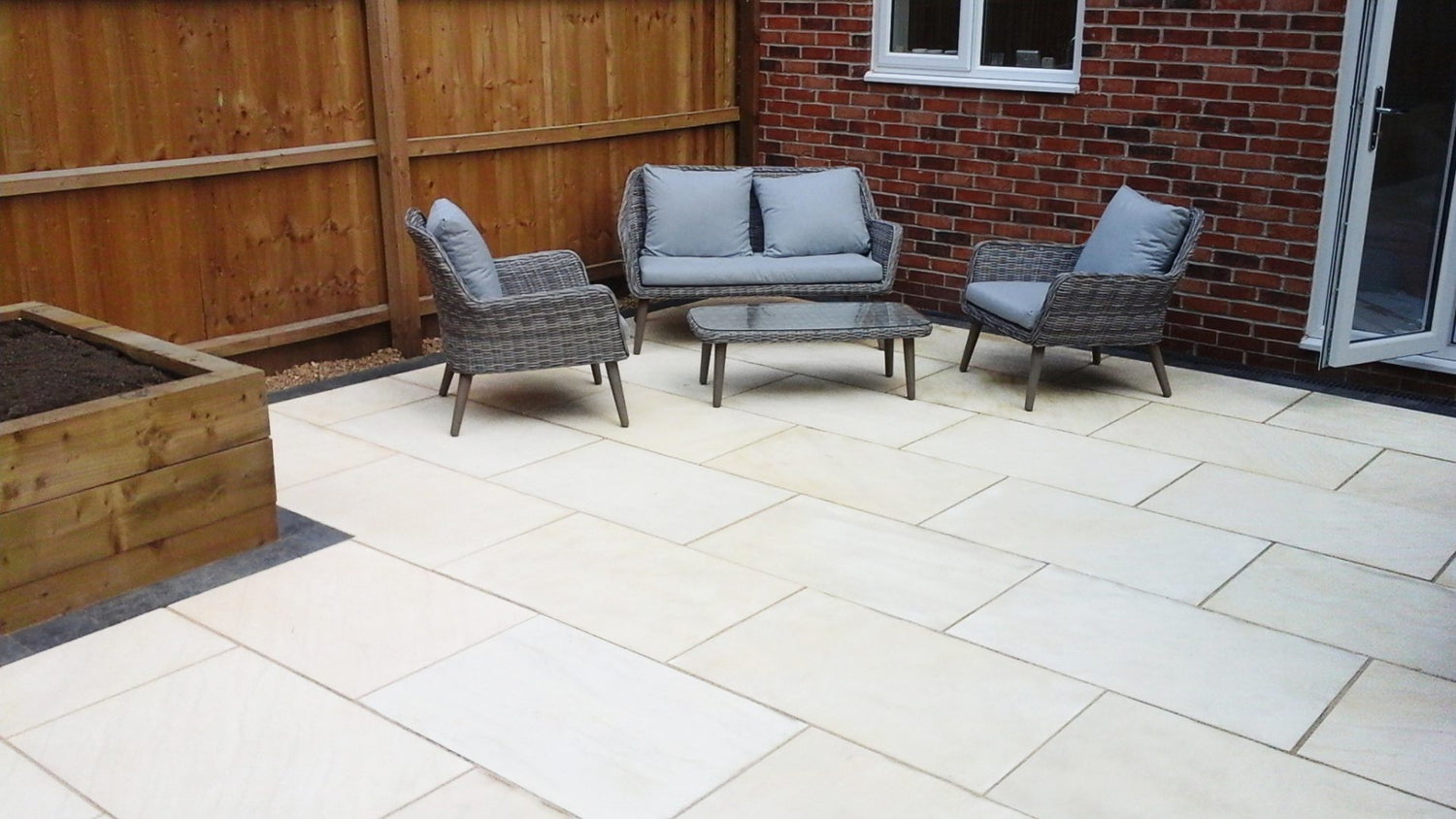
10 Beautiful and Practical Garden Path Ideas for a Stunning Outdoor Space
Share
.jpg)
Garden paths are defined as a designated route or walkway within a garden, intended for both functional and aesthetic purposes. They provide a defined space for walking and add structure and design to a garden. Garden paths can be made of various materials and designed in different ways, making them a versatile and important aspect of garden landscaping.
Garden paths are an essential element in any modern 2024 paved garden trend and design. They provide a clear and safe path for visitors to navigate through the garden, preventing trampling on plants and other areas. Additionally, they add an aesthetic appeal to the garden, leading the eye and creating a sense of exploration and adventure.
There are various materials that can be used for garden paths, each with its own unique characteristics and benefits. These include:
- Sandstone: A durable and natural-looking option that can be arranged in various patterns and shapes.
- Gravel: A cost-effective and easy-to-install option that can also help with drainage.
- Brick: A classic and elegant choice that can create a traditional or modern look depending on the design.
- Wood: A natural and warm option that can be easily customized and blended into the surrounding landscape.
- Porcelain: A high end more expensive option for a glossy look.
When choosing garden path materials, several factors should be considered, such as the climate of the area, maintenance requirements, and aesthetic appeal. For example, a wood path may not be suitable for a wet and humid climate, while a stone path may be high maintenance in a harsh winter climate.
Garden paths can be designed in various ways to fit the overall aesthetic of the garden. Some common designs include:
- Straight paths: Simple and straightforward, these paths can create a clean and organised look.
- Curved paths: These paths add a sense of flow and movement to the garden, creating a more natural and organic look.
- Stepping stone paths: These paths use individual stones or pavers placed strategically throughout the garden, creating a sense of discovery and exploration.
- Mosaic paths: These paths use different coloured stones or pavers to create intricate designs and patterns, adding a unique and eye-catching element to the garden.
Some creative garden path ideas include a secret garden path, a zen garden path, a fairy tale garden path, and a vegetable garden path. These ideas allow for personalisation and can add a fun and whimsical touch to the garden. By incorporating these elements, garden paths can transform a simple garden into a beautiful and functional space for all to enjoy, don't forget to keep the path wide enough we've enjoyed plenty of summers watching our grandson go up and down the path in his electric kids car, the wheels easily gain traction on the paving.
Key Summaries:
- Garden paths are important features in any outdoor area as they provide practicality and visual appeal.
- When choosing materials for a garden path, factors such as climate, upkeep, and overall design should be taken into consideration.
- Designing a garden path can be a creative and personal journey, with choices ranging from curved paths, mosaic paths, to themed paths.
What Are Garden Paths?

Photo Credits: Www.Pavingshopper.Co.Uk by Thomas Roberts
Garden paths are walkways that are present within a garden and are used to provide a designated route for people to move around the area. They serve both practical and aesthetic purposes by guiding visitors and separating different sections of the garden.
Garden paths can be created using various materials such as gravel, paving stones, or wood, depending on the desired appearance and atmosphere. They can be straight or curved, leading to different garden features or creating interesting focal points.
The addition of garden paths not only improves accessibility but also adds structure and visual attractiveness to the overall garden design.
Why Are Garden Paths Important?

Photo Credits: Www.Pavingshopper.Co.Uk by Dennis Walker
Garden paths offer both aesthetic and practical benefits in landscaping. Firstly, they enhance the overall visual appeal of a garden, providing a structured and organised look. Secondly, garden paths serve a functional purpose by guiding visitors through different areas of the garden, preventing trampling of delicate plants. Additionally, they help prevent soil compaction and erosion by providing designated walkways. Moreover, garden paths create a sense of exploration and discovery, encouraging visitors to explore different corners of the garden. Ultimately, garden paths contribute to the overall enjoyment and experience of a well-designed garden.
What Materials Can Be Used for Garden Paths?

Photo Credits: Www.Pavingshopper.Co.Uk by Bradley White
A garden path is not only a functional element in a garden, but it can also add aesthetic appeal and create a sense of structure and organisation. When it comes to choosing materials for your garden path, the options are endless. In this section, we will explore the various materials that can be used for garden paths, including stone, gravel, brick, and wood. Each material has its own unique benefits and can contribute to the overall look and feel of your garden. Let's take a closer look at the possibilities for your garden path.
1. Stone
Stone is a popular material for garden paths due to its durability and natural beauty. Creating a stone path involves a few simple steps:
- Plan the layout and width of the path.
- Prepare the area by removing any grass or debris.
- Level the ground and add a layer of sand for stability.
- Place the stones, leaving a small gap between each for stability and drainage.
- Fill the gaps with sand or gravel and compact the stones.
- Add edging to keep the stones in place.
- Regularly maintain the path by removing weeds and adding more sand or gravel if needed.
Stone paths have been used for centuries and can be found in ancient gardens and historical sites around the world. The Romans, for example, were known for their intricate stone pathways in gardens such as Villa dei Misteri in Pompeii. These paths not only served a practical purpose but also added to the overall aesthetic appeal of the garden.
2. Gravel
Gravel is a popular material for garden paths due to its affordability, versatility, and ease of installation. Here are the steps to create a gravel garden path:
- Prepare the path: Clear the area of any vegetation, rocks, or debris.
- Mark the path: Use string or spray paint to mark the desired path shape and width.
- Excavate the path: Dig the path to a depth of around 4-6 inches to accommodate the gravel.
- Install edging: Place edging material along the edges of the path to contain the gravel and prevent it from spreading.
- Lay landscape fabric: Lay a layer of landscape fabric over the excavated path area to suppress weed growth.
- Add a layer of gravel: Pour a layer of gravel onto the fabric, spreading it evenly with a rake or shovel.
- Compact the gravel: Use a tamper or the back of a shovel to compact the gravel, creating a stable and even surface.
- Add additional layers: Repeat steps 6 and 7 to achieve the desired thickness of the gravel path.
- Finish the path: Smooth the surface of the gravel path and ensure all areas are evenly covered.
Gravel has been used for pathways for centuries, dating back to ancient civilizations such as the Romans. The Romans utilized gravel for the construction of their intricate road systems, recognizing its strength and durability. Over time, gravel paths have evolved from functional footpaths to decorative elements in garden design. Today, gravel paths continue to be a popular choice for their practicality, aesthetic appeal, and timeless charm.
3. Brick
Brick is a popular material for garden paths due to its durability and timeless aesthetic. Here is a list of steps to consider when using brick for your garden path:
- Prepare the area by removing any existing vegetation and leveling the ground.
- Measure and mark the dimensions of the path.
- Excavate the path to a depth of around 4-6 inches.
- Add a layer of gravel and compact it to create a stable base.
- Lay a layer of sand on top of the gravel and level it.
- Start laying the bricks, ensuring they are tightly packed and level.
- Use a rubber mallet and level to adjust the bricks as needed.
- Fill the gaps between the bricks with sand or mortar.
- Compact the path using a plate compactor.
- Optional: Add edging for a finished look and to prevent shifting.
4. Wood
When considering wood as a material for garden paths, there are several steps to follow:
- Choose the right type of wood: Opt for durable and weather-resistant woods like cedar or redwood.
- Prepare the area: Clear the path of any vegetation, level the ground, and install landscape fabric to prevent weed growth.
- Measure and mark the path: Use stakes and string to outline the desired path shape and width.
- Install edging: Place metal or plastic edging along the sides of the path to keep the wood in place.
- Lay the wood: Install the wood planks or logs along the marked path, securing them with stakes or screws.
- Maintain the wood: Regularly inspect and treat the wood with appropriate sealants or stains to protect it from weathering and rot.
Wooden garden paths add a natural and rustic charm to outdoor spaces. They blend well with gardens, providing a warm and inviting atmosphere. Consider incorporating wood into your garden path design for a unique and aesthetically pleasing touch.
What Factors Should Be Considered When Choosing Garden Path Materials?

Photo Credits: Www.Pavingshopper.Co.Uk by Brandon Jackson
When planning a garden path, there are several factors to keep in mind to ensure that it is not only functional but also aesthetically pleasing. From considering the climate to choosing low-maintenance materials, each decision can impact the overall look and feel of your garden. In this section, we will discuss the key factors that should be taken into account when selecting materials for your garden path, including the climate in your region, the level of maintenance required, and the desired aesthetic appeal.
1. Climate
When designing a garden path, considering the climate is crucial for selecting the right materials that can withstand the weather conditions. Here are the steps to consider:
- Research the climate of your region to determine the average temperature, rainfall, and potential extreme weather events.
- Choose materials that can tolerate the climate, such as stone or brick for hot and dry climates, or wood for mild and moist climates.
- Consider the freeze-thaw cycle if you experience freezing temperatures, as some materials may crack or deteriorate.
- Opt for non-slip materials in areas prone to rain or snow to ensure safety.
Pro-tip: Consulting with a local garden expert can provide valuable insights into the best materials for your specific climate.
2. Maintenance
Maintaining garden paths is essential to keep them functional and visually appealing. Follow these steps for successful maintenance:
- Regular cleaning: Remove debris, fallen leaves, and weeds from the path.
- Repair damages: Fill in any cracks, replace broken pavers, and fix loose stones.
- Weed control: Use weed barriers or apply organic weed killers to prevent weed growth around paving.
- Regular inspections: Check for any signs of erosion, unevenness, or water pooling.
- Seasonal care: Adjust path materials based on weather conditions and protect them during harsh winters.
Pro-tip: Applying a sealant to the path surface can enhance durability and simplify future maintenance.
3. Aesthetic Appeal
When choosing garden path materials, aesthetic appeal plays a crucial role in creating an attractive outdoor space. Consider the following steps to enhance the aesthetic appeal of your garden paths:
- Select materials that complement the overall theme or style of your garden.
- Choose colours that harmonise with the surrounding landscape and plants.
- Incorporate patterns or designs using different materials, such as mosaic tiles or contrasting bricks.
- Add decorative elements along the path, like garden sculptures or lighting fixtures.
For a truly stunning garden path, consider these suggestions:
- Create a whimsical fairy tale garden path with stepping stones and enchanting decorations.
- Design a zen garden path using smooth stones and minimalist landscaping.
- Construct a secret garden path with an arched entrance and lush foliage.
- Build a vegetable garden path using reclaimed wood and herb markers.
How Can Garden Paths Be Designed?

Photo Credits: Www.Pavingshopper.Co.Uk by William White
When it comes to designing a garden path, there are several options to consider. Each type of path can add a unique touch to your garden and enhance its overall appearance. In this section, we will explore four different ways to design garden paths: straight paths, curved paths, stepping stone paths, and mosaic paths. By learning about the characteristics of each option, you can choose the perfect garden path design for your own outdoor space.
1. Straight Paths
Straight paths are a popular choice for garden designs due to their simplicity and functionality. To create a straight path in your garden, follow these steps:
- Plan the path: Determine the desired width and length of the path.
- Mark the path: Use string or stakes to mark the edges of the path.
- Excavate the area: Remove any grass, weeds, or debris along the path.
- Level the ground: Use a shovel or rake to ensure the path is level and even.
- Add a base layer: Lay down a layer of crushed stone or gravel to provide stability.
- Compact the base: Use a tamper or roller to compact the base layer.
- Add the paving material: Choose your desired material, such as concrete, pavers, or flagstones, and lay them in a straight line along the path.
- Secure the material: Fill the gaps between the paving material with sand or gravel and compact it.
- Finish the edges: Install edge restraints or border materials to keep the path in place.
- Maintain the path: Regularly clean and sweep the path to keep it tidy and free of debris.
By following these steps, you can easily create a straight path in your garden that adds structure and functionality to your outdoor space.
2. Curved Paths
Curved paths can add visual interest and a sense of flow to your garden. Here are some steps to create curved paths:
- Determine the path's purpose and desired location.
- Outline the path using a garden hose or rope.
- Remove the sod or existing vegetation along the path.
- Excavate the path to a depth of about 4-6 inches.
- Create a base layer using crushed gravel or sand.
- Compact the base layer using a tamper or plate compactor.
- Lay the curved path materials, such as stones or bricks, following the outline.
- Fill the gaps between the materials with sand or gravel.
- Compact the path again to ensure stability.
- Add finishing touches like edging or plants alongside the path.
3. Stepping Stone Paths
Stepping stone paths can add charm and functionality to your garden. Here are the steps to create one:
- Plan the layout: Determine the path's length, width, and shape.
- Clear the area: Remove any plants, rocks or debris from the path's location.
- Prepare the ground: Level the soil and add a layer of sand for stability.
- Place the stepping stones: Arrange the stones, leaving equal spacing between each one.
- Secure the stones: Press them into the sand and ensure they're level and stable.
- Fill the gaps: Fill the spaces between the stones with gravel, mulch or moss.
- Maintain the path: Regularly check for weeds, moss or uneven stones.
Fun fact: Stepping stone paths have been used in Japanese gardens for centuries to create a sense of tranquillity and harmony.
4. Mosaic Paths
Creating mosaic paths in your garden can add a unique and artistic touch to your outdoor space. Here are the steps to create a beautiful mosaic path:
- Plan the design: Decide on the pattern and colours you want for your mosaic path. Consider using tiles, glass pieces, or stones.
- Prepare the base: Clear the area and level the ground where the path will be. Remove any grass or debris.
- Lay the foundation: Apply a layer of concrete or mortar to create a sturdy base for the mosaic tiles.
- Arrange the mosaic tiles: Carefully place the tiles or glass pieces on the wet mortar, following your design. Press them firmly into place.
- Grout the tiles: Once the tiles are set, apply grout between them, filling in the gaps. Wipe away any excess grout.
- Clean and seal: Clean the mosaic path with a damp cloth or sponge, removing any grout residue. Apply a sealant to protect the tiles from moisture and dirt.
- Enjoy your mosaic path: Once the path is dry and sealed, step back and admire your beautiful and unique garden feature.
What Are Some Creative Garden Path Ideas?

Photo Credits: Www.Pavingshopper.Co.Uk by David Jackson
Creating a garden path not only serves a functional purpose, but it can also add a touch of creativity and charm to your outdoor space. Let's explore some unique and imaginative garden path ideas that will elevate your garden to the next level. From a hidden secret garden path to a peaceful Zen garden path, we'll take a closer look at each sub-section and the elements that make them special. Get ready to be inspired and transform your garden into a whimsical wonderland.
1. Secret Garden Path
Creating a secret garden path adds an element of mystery and enchantment to your outdoor space. Here are the steps to create a secret garden path:
- Choose a secluded area in your garden for the path.
- Clear the area of any plants or debris.
- Mark the path's boundaries using stones or bricks.
- Excavate the soil along the marked path.
- Add a layer of gravel or sand to create a stable base.
- Place stepping stones or wooden planks along the path.
- Add plants, such as creeping vines or shrubs, to create a sense of enclosure.
- Install a gate or archway at the entrance for a dramatic effect.
- Add lighting to illuminate the path at night.
A secret garden path can transform your outdoor space into a magical retreat, providing a hidden escape for relaxation and exploration.
2. Zen Garden Path
Creating a Zen garden path involves careful planning and attention to detail. Here are the steps to create a serene and peaceful path:
- Choose a location: Select a quiet and secluded area in your garden for the Zen garden path.
- Select materials: Use natural elements like stones or pebbles to create a calming and harmonious atmosphere.
- Lay the path: Arrange the stones or pebbles in a pattern that encourages mindfulness and contemplation.
- Add plants: Integrate lush greenery or bonsai trees along the path to enhance the Zen aesthetic.
- Create focal points: Incorporate features like a meditation bench, lanterns, or a small waterfall to create a sense of tranquility.
- Maintain simplicity: Keep the design minimal and uncluttered to promote a sense of peace and clarity.
3. Fairy Tale Garden Path
Creating a fairy tale garden path adds charm and whimsy to your outdoor space. Follow these steps to bring your fairy tale dreams to life:
- Choose a theme: Decide on a fairy tale or storybook theme that inspires you.
- Select materials: Use natural stones, colorful tiles, or whimsical stepping stones to create your path.
- Add decorative elements: Incorporate fairy tale-themed decorations like fairy houses, gnome statues, or enchanted flowers.
- Plant magical flowers and plants: Choose flowers and plants that evoke a magical atmosphere, such as lavender, roses, and ferns.
- Install garden lighting: Use fairy lights or solar-powered lanterns to illuminate the path and create a magical ambiance at night.
Pro-tip: To create an even more enchanting fairy tale garden path, add a small fountain or waterfall feature to create a soothing and magical atmosphere.
4. Vegetable Garden Path
When creating a vegetable garden path, there are several steps to consider:
- Determine the location and width of the path. Consider the space needed for walking and wheelbarrow access.
- Clear the area of any vegetation or obstacles, ensuring a clean path.
- Prepare the soil by removing rocks, weeds, and debris.
- Add a layer of landscape fabric to prevent weed growth.
- Choose a suitable material for the path, such as gravel or wood chips, ensuring it is safe for the vegetables and easy to maintain.
- Spread the chosen material evenly over the path, creating a smooth surface.
- Compact the material to ensure stability and durability.
- Consider adding stepping stones or markers to guide visitors through the path.
- Maintain the path regularly by removing weeds and replenishing the material when necessary.
By following these steps, you can create a functional and attractive vegetable garden path that enhances the overall beauty and accessibility of your garden.
What Are the Best Materials for Garden Paths?

Photo Credits: Www.Pavingshopper.Co.Uk by Ralph Thompson
Choosing the best materials for garden paths depends on factors such as durability, aesthetics, and cost. Here are some options to consider:
- Gravel: Affordable and easy to install, gravel provides a casual, rustic look.
- Flagstone: Durable and versatile, flagstone offers a natural, elegant appearance.
- Brick: Traditional and charming, brick is durable and available in various colors and patterns.
- Concrete: Low-maintenance and long-lasting, concrete can be stamped or stained for a personalized look.
- Wood: Ideal for a more organic feel, wood adds warmth but requires regular maintenance.
Before selecting the best materials for your garden paths, consider your specific preferences and needs.
How Can Garden Paths Enhance Your Outdoor Space?

Photo Credits: Www.Pavingshopper.Co.Uk by Joseph Nelson
Adding a well-designed garden path can greatly enhance the overall look and functionality of your outdoor space. Here are some steps to consider when creating garden paths:
- Plan the layout and design of your garden path to complement the existing landscape.
- Select a suitable material for your path, such as gravel, stepping stones, or pavers.
- Prepare the ground by removing any grass or weeds and leveling the area.
- Install the chosen material, ensuring it is properly aligned and secured.
- Add edging to define and contain the path, such as bricks or decorative stones.
- Incorporate lighting along the path for safety and ambiance during the evening hours.
- Consider adding plants or flowers alongside the path to create a visually appealing and inviting atmosphere.
By following these steps, you can create a beautiful garden path that enhances your outdoor space and provides a pleasant and functional pathway for you and your guests.
How to Create a Modern Garden Path?

Photo Credits: Www.Pavingshopper.Co.Uk by Albert Anderson
Creating a modern garden path involves careful planning and attention to detail. Here are the steps to follow:
- Choose a design: Decide on the shape and layout of your path, considering the overall style of your garden.
- Select materials: Opt for modern materials like concrete, natural stone, or sleek tiles to achieve a contemporary look.
- Prepare the area: Clear the path of any obstacles and level the ground to ensure a smooth surface.
- Install edging: Use metal or concrete edging to define the boundaries of your path and add a modern touch.
- Lay the path: Place the chosen materials in a pattern or arrangement that complements the design and aligns with your vision.
- Add lighting: Install modern outdoor lighting along the path to enhance its visibility and create a striking effect at night.
- Accessorize: Consider adding contemporary elements like potted plants, sculptures, or minimalist seating to further enhance the modern aesthetic.
- Maintain regularly: Keep the path clean and weed-free, ensuring it remains in good condition for years to come.
Summary

Photo Credits: Www.Pavingshopper.Co.Uk by Jason Hall
Garden paths are a crucial aspect of any landscape design, as they provide both practicality and visual appeal. They act as a guide, leading visitors through the garden while adding structure and defining different areas. When creating garden paths, it is important to consider factors such as the garden's overall style, the materials used, and the desired level of maintenance. Whether you prefer a formal and organized path or a more natural and relaxed look, there are countless options to choose from. Ultimately, a well-designed garden path will enhance the overall beauty and enjoyment of your outdoor space.
Frequently Asked Questions
What are some modern garden path ideas that are trendy and popular?
Some popular modern ideas are using different sized patio kits, creating wood decking levels, and leading to artistic features like pathways of curved paving. Contemporary paths stand out with unique shapes and materials.How can I create a cohesive and contemporary look in my garden with a path?
Use clean lines, geometric shapes, and mix materials like square stepping stones and wood stairs for a modern style. Porcelain tiles provides a sleek, contemporary look.What are some budget-friendly options for creating a garden path?
Gravel and reclaimed bricks or fieldstone are cost-effective solutions. Cheap paving packs offer affordable, uniform paver options.How can I incorporate plants and flowers into my garden path design?
Leave space between stepping stones for grass to grow. Add plant borders or flower gardens along the path for pops of color. Strategically placed planters also enhance paths.Are there any psychological benefits to incorporating water into a garden path?
Studies show water has positive mental health effects. Consider small water features like streams or fountains to incorporate soothing water elements.What materials should I consider when designing a backyard pathway?
Choose materials that match your home's style and landscaping, like brick, gravel, flagstone, or patio packs. Smooth sandstone adds natural texture.How can I add lighting to enhance a garden path?
Strategically placed path lighting creates ambience and illuminates walkways at night. Consider uplights, suspended lighting, or lighting incorporated into handrails. Use solar lights for an eco-friendly option.What are some ways to make a narrow garden path feel more spacious?
Using lighter colored materials can visually open up a narrow path. Raising paths onto decking gives the illusion of more space. Minimal plantings and boundaries prevent clutter. Lighting also brightens darker, confined areas.How can I make my garden path accessible for those with mobility challenges?
Avoid uneven materials like gravel or dirt. Use smooth, flat pavers and ensure the path remains level. Make wide enough for wheelchairs at least 3 feet across. Add handrails if needed.Related Posts
-

Is Sandstone Paving Permeable? Is it porous?
Sandstone's porous nature enables it to absorb rainfall, qualifying it as a permeable paving variety. However, seali...
-

How to remove moss from patio paving
Moss growth is a common issue for patio paving, especially in damp, shaded areas. While moss may seem harmless, it ca...
-

Stunning Garden Water Feature Ideas - Enhance Your Outdoor Space
Garden water features are decorative elements that incorporate water into a garden, adding beauty and a sense of...
-
Does Patio Paving Need Edging? A Comprehensive Guide
In this article, we'll explore the importance of patio edging, the different types of edging materials available, and...








